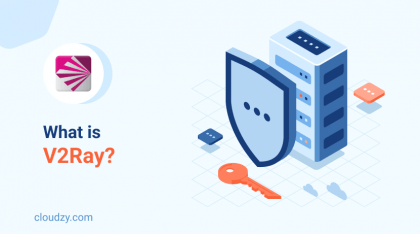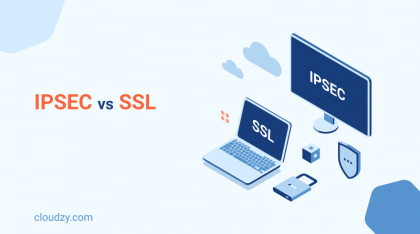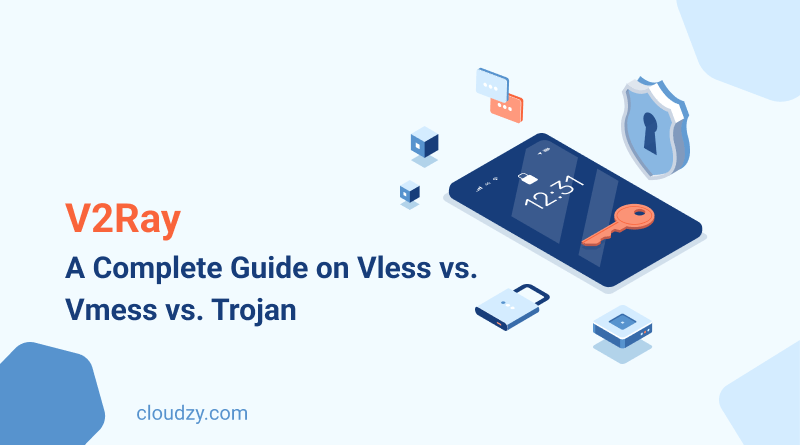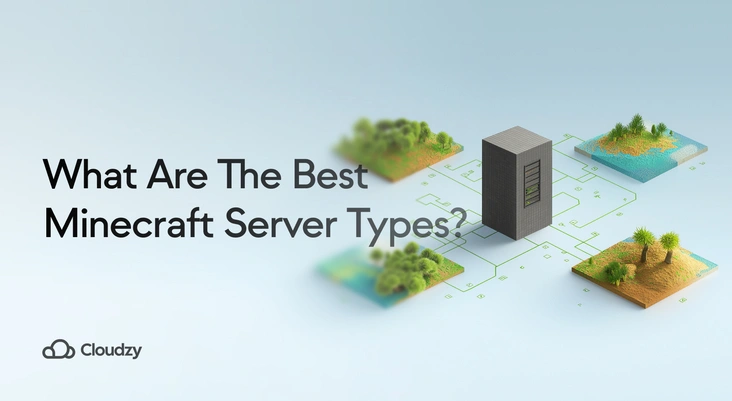In a world full of cyber criminals, no security measure to keep your information safe is extra. In many scenarios, your online data is at risk of getting attacked by hackers; using public Wi-Fi is one common dangerous scenario. So, the wise thing would be to secure your data by using a VPN.
In this post, we will delve deeper into the world of V2Ray, exploring its features, advantages, and limitations, and we’ll provide a thorough source for Vless VS. Vmess VS. Trojan comparison. So, you know which V2Ray protocol suits your connection.
What is v2ray?
As the core part of project V, V2Ray is a tool that provides a secure platform for making private networks. V2Ray was developed in 2015 as an alternative to Shadowsocks and has now gained popularity among users worldwide. The primary purpose of V2Ray is to help users secure their data and protect their online activity. V2Ray can work as a solo privacy tool or even in combination with other available tools to make a more comprehensive security solution. Making a proxy server with V2Ray is not difficult at all. Since it’s an open-source platform, using the modules provided by V2Ray, any developer can make a V2Ray server.
But Why is it such a popular security tool? To answer this question, we have to review its most important features:
- You can customize the routing of your data: You can choose where the incoming traffic is sent by modifying the routing config.
- Support for multiple active proxies at the same time.
- Support for a variety of protocols, including Vless, Vmess, Socks, etc.
- Compatibility with almost all operating systems.
- Built-in obfuscation to mask the data you’re transmitting.
- The ability to build tunnels to local hosts using a reverse proxy, mainly to secure web servers.
To further explain the unique features of V2Ray, it’s important to note that V2Ray is mainly optimized for Transmission Control Protocol (TCP), although it has basic User Datagram Protocol (UDP) support. One key feature that sets V2Ray apart from other tools is its ability to support multiple inbound/outbound proxies. This means that in one V2Ray instance, we can have both inbound and outbound protocols, and each protocol can be independent.
With all these intriguing features, V2Ray already exceeds many security and privacy solutions out there.

How Does v2ray Work?
Now, to better grasp why V2Ray is widely used and popular, let’s see how it works. V2Ray operates on principles similar to other proxy tools, meaning that it uses a specific transit server to complete data transmission, allowing proxy internet access. For instance, users can access websites like Google and YouTube through a proxy server. By connecting to the proxy server through the V2Ray core, the proxy server obtains the website’s content and sends it back to the user. In this way, users can access websites’ information without jeopardizing their data and their IP address. To establish a successful connection, both the server and client software require the user to provide specific parameters according to different protocols, such as UUID (Universally Unique Identifier), key, encryption method, etc. The connection can only be established when the two parties agree on these parameters.
How Can a VPN Server Take Your v2ray Experience to the Next Level?
Using a cloud VPS to host your own VPN eliminates the hassles of dealing with third party VPN providers and offers extra security. If you want to experience the liberating world of V2Ray and its powerful protocols with a combination of other powerful and commonly used VPN protocols, we have the best offer for you.
Cloudzy’s platform features an easy-to-use, instant setup routine and impressive 24/7 customer service. A third-party VPN provider gives you access to a limited set of VPN protocols, but when you have your own VPN server, you can use a variety of protocols that suit your needs. All the powerful and fast V2Ray protocols such as Vless and Vmess are can be configured on cloud VPS along with other popular VPN protocols such as MTProto and Shadowsocks. This plan has a 99.95% uptime guarantee, 24/7 support, and four active server locations. On top of all of these features, you don’t even have to pay monthly; you can pay as you go. All you have to do is get a Cloud VPS and get your hands dirty on setting up your own V2Ray VPS.
Want a high-performance Cloud VPS? Get yours today and only pay for what you use with Cloudzy!![]() Cloud VPS
Cloud VPS
vless vs. vmess vs. Trojan
V2Ray is a powerful proxy platform that supports a variety of protocols. In this part of the post we’ll introduce each of the protocols V2Ray provides and thoroughly compare them.
In this section, we compared Vless VS. Vmess VS. Trojan. All of these protocols are designed to provide a fast and secure connection. However, they have some distinct features that set them apart. When comparing Vless VS. Vmess VS. Trojan, it’s important to consider factors such as performance, flexibility, and security.
vless
Vless is the newest protocol of V2Ray. It was added to the V2Ray protocol package in version 4.28 in 2020. V2Ray Vless is a relatively lightweight and efficient protocol because it uses a simplified handshake process to reduce resource usage and increase performance. In a normal handshake process, the client and the server exchange lots of messages to reach an agreement for the encryption keys and other crucial parameters of a secure connection. V2Ray uses a streamlined version of this process, reducing the number of messages exchanged between the client and the server. Since V2Ray Vless can operate faster and use less CPU power than other protocols, it’s perfect for users who prioritize performance over other factors.
Another notable fact about Vless is that it uses ChaCha20-Poly1305 for encrypting your data. This method is a combination of two powerful encryption algorithms, Poly1305 and ChaCha20, making it faster than the common AES-GCM algorithm.
Now, let’s move on to Vmess protocol to have a better sense of differences between Vmess VS. Vless.
vmess
V2Ray Vmess is a TCP-based protocol that has been around for a long while. This protocol supports a wider range of encrypting algorithms, including AES-128-GCM, AES-256-CBC, and SHA-256. The most interesting fact about Vmess is its support for custom headers. Headers are small pieces of information added to data packets when they are traveling over the Internet. The custom header feature in Vmess allows adding fake, irrelevant, and random data. This additional information makes it more difficult for censors of the network to detect VPN activity as it seems like regular Internet traffic. VMess is divided into inbound and outbound parts and acts as a bridge between the V2Ray client and server. Comparing Vless VS. Vmess based on the handshake processes is also important. Because, unlike other protocols, Vmess doesn’t use handshaking between the client and the server because it doesn’t use common encryption methods. VMess uses an asymmetric format. In an asymmetric format, the request sent by the client and the response from the server are in different formats, getting rid of the necessity for handshaking and traditional encryption systems. This asymmetric encryption system works by generating one key for encryption and one for decryption. So, instead of negotiating over a shared secret key, the client and the server each have a set of public and private keys. VMess also offers advanced features such as traffic obfuscation and multiple encryption methods, making it a more feature-rich protocol than Vless. Vmess is also highly customizable since it allows for adjusting the parameters and fine-tuning the settings of the connection.
Trojan
Trojan is another V2Ray protocol that aims to provide a more secure and efficient communication channel between the client and the server. The protocol is designed to be harder to detect and block than traditional VPN protocols such as OpenVPN or IPSec. V2Ray Trojan protocol works by encapsulating the traffic inside an SSL/TLS encrypted tunnel, making it difficult for network administrators to differentiate Trojan traffic from regular SSL traffic. This high level of security is further augmented by a unique password-based authentication method that helps keep the protocol secure from eavesdropping attacks.

Trojan also offers users the flexibility to choose which ports they want to use and uses a customized WebSocket protocol encrypted with TLS, making it highly secure. This protocol is compatible with most modern web browsers and servers, making it a popular choice for those who are highly concerned about their security. Trojan offers a perfect fallback mechanism, effectively preventing active detection and ensuring that users have secure and private communication.
The Trojan protocol is named after the Trojan horse, as it attempts to disguise itself as legitimate traffic to avoid detection. Since the Trojan protocol is a newer protocol used by V2Ray, its downside is that it is not as widely supported as other protocols, making it more challenging to find compatible apps.
In total, the Trojan protocol is a highly secure and efficient protocol that provides a more flexible and user-friendly communication solution for users. Its unique format, high-level security, compatibility with most modern web browsers and servers, and flexibility in network settings make it a popular choice among users who care to stay secure at all times. While it may not be as widely supported as other protocols, the Trojan protocol’s advantages compensate for this drawback.
Now let’s provide an overall technical comparison in the Vless VS. Vmess VS. Trojan debate. VMess is a more advanced protocol that offers more features and capabilities than Vless and Trojan. This versatility makes V2Ray VMess an excellent choice for users who require advanced features and customization options and those who require a more secure connection.
The comparison between Vless VS. Vmess VS. Trojan is only about security of protocols and different strengths and limitations. Vless and Tojan are both lightweight protocols optimized for high performance and lower resource usage. Although all three protocols have great strategies for keeping your online information safe, Trojan is a better choice for this matter.
| Feature | Vless | Vmess | Trojan |
| Encryption | AES-128-GCM, AES-256-GCM | AES-128-CBC, AES-256-CBC | AES-128, AES-256, ChaCha20 |
| Obfuscation | Yes | Yes | Yes |
| Performance | High | High | High |
| Flexibility | Limited support (such as HTTP) | Supports various types of traffic | Limited support (HTTP and FTP) |
| Handshake Process | One-way | Two-way | Two-way with optional client verification |
What is Xray?
Another protocol that further expands V2Ray’s abilities is Xray. Xray improves the flaws of the original V2Ray code by introducing additional technologies such as XTLS. Xray XTLS protocol aims to enhance communication efficiency and allows Xray to work at a faster speed. XTLS, one of Xray’s key features, is an improvement over V2Ray’s WS TLS protocol, which is less optimized for communication over the Internet. In addition to XTLS, Xray also features a powerful routing system that is highly customizable, allowing users to meet their various user needs. With its flexibility, Xray is an excellent choice for those who require a more adaptable protocol.
The compatibility of Xray with V2Ray fetches a seamless VPN operation with the original V2Ray configuration files and API calls making the Xray V2Ray combination an attractive option for those already using V2Ray.
Final Words
While V2Ray is a popular option, it is not the only protocol available on the market. Other protocols like Shadowsocks and OpenVPN also offer some unique strengths. However, V2Ray stands out among the rest with its versatility, flexibility, and spectacular ability to secure your online information. It also supports many protocols, such as Vless, VMess, and Trojan, making it a more comprehensive solution. In the Vless VS. Vmess VS. Trojan debate, each of these protocols has its technical strengths and limitations, which makes a choice between them depending on the user’s specific needs. For instance, Vless is a lightweight protocol ideal for low-power devices, while VMess offers enhanced security and privacy features.
When choosing a protocol, it is essential to consider factors such as speed, security, and the ability to protect your data the best way possible. Users can choose the protocol that best meets their needs with its support for various protocols like Vless, VMess, Trojan, and Xray. In total, V2Ray provides a reliable and secure platform that is worth considering for your online communication needs.
FAQ
What is V2Ray?
V2Ray is an open-source project that is designed and used for making private networks. Its main purposes are protecting users’ information and providing them with online privacy.
How does V2Ray compare to other VPNs in case of speed and performance?
In terms of performance, V2Ray is a proxy software that can handle large amounts of traffic data. It’s also a versatile tool that can be configured with a focus on different parameters and for different situations. It also offers a wide range of protocols with different customization options. All these features make it a competitive tool, regarding the fact that most VPNs with similar features and performance cost a lot.
Can V2Ray be used on all operating systems?
V2Ray can be installed and used on many operating systems, such as Android, Linux, Windows, macOS, etc.
Does V2Ray keep logs of user activity?
V2Ray is an open-source project designed to provide privacy-focused VPN connections. So, as long as it’s not used in combination with third-party VPN providers, it doesn’t keep any logs of users’ activity.




